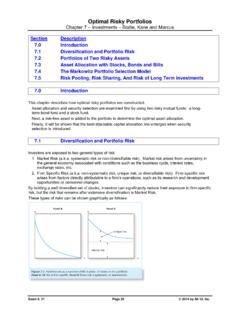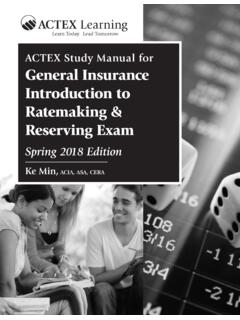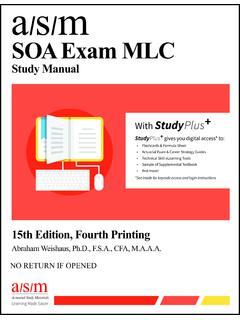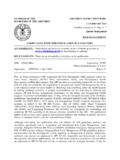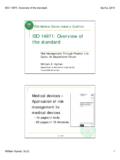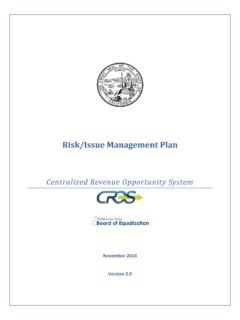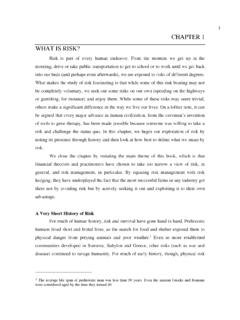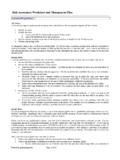Transcription of dvd for notes.20061028 - ACTEX / Mad River
1 Copyright ACTEX 20061 ACTEX SeminarExam PWritten & Presented byMatt Hassett, ASA, PhD2 This is an eight hour :213 This is a review is an actuarial exam may want to study more will focus more on problem solvingthan assumes that you have already studied ACTEX 20063 probability for Risk management (Text and Solutions manual)Matt Hassett & Donald StewartACTEX PublicationsACTEX Study Guide(SOA Exam P/CAS Exam 1)Sam BrovermanACTEX PublicationsOther Study Materials:yy4 Don t spend too much time on one Strategy:213 Maximizethe number of questionsanswered easier problems ACTEX 20065 Points to Remember:yyExpect multiple skill problems.
2 Algebra and calculus skills are assumed and TV screen holds less content than a blackboard; use your handout pages for Rule: probability Rules:y() (~) 1-()PEP EPE ==Disjunction Rule:y()()()-()PA B PA PB PA B = + Copyright ACTEX 20067 probability Rules, cont.:Definition:yTwo events and are called if ABAB = mutually exclusiveAddition Rulefor Mutually Exclusive Events:yIf A B= , P(A B) = P(A) + P(B)8 The probability that a visit to a primary care physician s (PCP) office results in neither lab work nor referral to a specialist is 35% . Of those coming to a PCP s office, 30% are referred to specialists and 40% require lab the probability that a visit to a PCP s office results in both lab work and referral to a specialist.
3 (A) (B) (C) (D) (E) :Copyright ACTEX 20069 Solution:Let Lbe lab work and S be a visit to a specialist.()() 1 PLSPLS = = () S =( ) and ( ) ()()() ( )( ) SPL PS PL SPL S = = + =+ () S =Answer A 10 You are given: Venn Diagrams Can Help:() andPA B =() B =(A) (B) (C) (D) (E) [ ].PACopyright ACTEX 200611 Venn Diagrams Can region() B =Area of the shaded region must be total area of the two circles represents:() B =Subtracting the area of the shaded region: () =Answer D 12A More Complicated Venn Diagram:(A) 280 (B) 423 (C) 486 (D) 880 (E) 896An insurance company has 10,000 policyholders.
4 Each policyholder is classified as young/old; male/female; and these, 3,000 are young, 4,600 are male, and 7,000 are married. They can also be classified as 1,320 young males, 3,010 married males, and 1,400 young married persons. 600 are young married many policyholders are young, female, and single?Copyright ACTEX 200613A More Complicated Venn Diagram:Y= youngM = maleH= marriedY=3,000MH60080072014A More Complicated Venn Diagram:Y= youngM = maleH= marriedY=3,000MH600800720880 Answer D 3, 000 720 600 800 880 =Copyright ACTEX 200615 Some Problems are Trickier:(A) 0 (B) 47/144 (C) 1/2 (D) 97/144 (E) 7/9An insurer offers a health plan to the employees of a company.
5 As part of this plan, each employee may choose exactly two of the supplementary coverages A, B, and C, or may choose no supplementary coverage. The proportions of the employees that choose coverages A, B, and Care 1/4, 1/3, and 5/12, the probability that a randomly chosen employee will choose no Problem, cont.:Find This is a linear system for x, y, z.()()1 PABCxyz = + + ABC0000yxzCopyright ACTEX 200617 Trickier Problem, cont.:1()041() 035()012PA x yPBy zPC xz=++==++==++=Solution:()()2/12,1/12,3/1 26111122xyzPABCxyz=== = + + = = Answer C ABC0000yxz18 More probability Rules:y()()(|)nA BnBPA B =Conditional probability by counting for equally likely outcomesyDefinition:For any two events Aand B, the conditional probabilityof Agiven Bis defined by()()(|)PA BPBPA B =Copyright ACTEX 200619 More probability Rules.
6 Multiplication Rule for probability ()()(|)PA BPBPA B =20A researcher examines the medical records of 937 men and finds that 210 of the men died from causes related to heart of the 937 men had at least one parent who suffered from heart disease, and, of these 312 men, 102 died from causes related to heart :Copyright ACTEX 200621 Find the probability that a man randomly selected from this group died of causes related to heart disease, given that neither of his parents suffered from heart , cont.:(A) (B) (C) (D) (E) :A= At least one parent with heart diseaseH = Died of causes related to heart disease()()()|nHAPH AnA = Find A: 312H:210937 Copyright ACTEX 200623 Solution:A: 312H:210A= At least one parent with heart diseaseH = Died of causes related to heart disease937108()~937 312 625nA= =()102nA H =()312nA=102()( ) 102 108nHA nH = = 24 Solution:Answer B A: 312H:210A= At least one parent with heart diseaseH = Died of causes related to heart disease937108102()()()108| AnA === Copyright ACTEX 200625A Harder Conditional Problem.
7 An actuary is studying the prevalence of three health risk factors, denoted by A, B,and C, within a population of women. For each of the three factors, the probability is that a woman in the population has only this risk factor (and no others). For any two of the three factors, the probability is that she has exactly these two risk factors (but not the other). The probability that a woman has all three risk factors, given that she has Aand B, is 1 Harder Conditional Problem, cont.:(A) (B) (C) (D) (E) is the probability that a woman has none of the three risk factors, given that shedoes not have risk factor A?Copyright ACTEX 200627 DeMorgan s Laws:()()AB ABAB AB = = 28 Harder Problem Solution:We want to find ()()()(|)[()]PA B CPA B C APAPABCPA = = ABCxis not ,()PA B C x =Copyright ACTEX 200629 Harder Problem Solution, cont.
8 In in each of the areas representing exactly two risk factors of the areas representing exactly one risk factor. , and fill in in each 30 Harder Problem Solution, cont. of a woman having all three risk factors given that she has Aand Bis 1/3. ()()()|1 3PA B C A BPA B CPA B == ()PA B C x =() B x =+ =+Copyright ACTEX 200631 Harder Problem Solution, cont. () +++=()()() 3 B C = ++=() = = () = 32 Harder Problem Solution, cont. ()[()](|) B C APA === Answer CCopyright ACTEX 200633 More probability Rules:yMultiplication Rule for Independent EventsyDefinition:Two events Aand B, are independent if(|) ()PA B PA=If Aand B, are independent,()()()PA B PAPB =34An actuary studying insurance preferences makes the following conclusions:(i) A car owner is twice as likely to purchase collision coverage as disability coverage.
9 (ii) The event that a car owner purchases collision coverage is independent of the event that he or she purchases disability coverage.(iii) The probability that a car owner purchases both collision and disability coverages is .Exercise:Copyright ACTEX 200635 What is the probability that an automobile owner purchases neither collision nor disability coverage?Exercise, cont.:(A) (B) (C) (D) (E) C be collision insurance and D be disability need to find Solution:()() = () 2()PCPD=i)iii)ii)()()()PC D PCPD =() D =Copyright ACTEX 200637 Solution, cont.:() ( ) ( ) 2 ( )( ) ( ) ( ) 2 ( ) 2 D PCPDPDPDPDPCPD= = == ===()()()()2 PCPDPCD = + =+ =()()11 = = = Answer B38A blood test indicates the presence of a particular disease 95% of the time when the disease is actually present.
10 The same test indicates the presence of the disease of the time when the disease is not present. 1% of the population actually has the the probability that a person has the disease given that the test indicates the presence of the Theorem -- Simplify with Trees:(A) (B) (C) (D) (E) ACTEX 200639 Solution:D= Person has the diseaseT = Test indicates the diseaseWe need to find()()()|PD TPD TPT =40 Solution, cont. ~D() T= () ~PDT= ()()()|PD TPD TPT =. ~ ~ +Answer B Copyright ACTEX 200641 Law of Total probability : probability Rules:Let E be an ,,nAA the sample space, then() ( )()()12+ .. +.nPE PA E PA EPA E= + 42 Theorem:Bayes Theorem:Let E be an ,,nAA the sample space, then()()()()( )()( )()( )111111||||nnPE APA EPEPA PA EPA PA EPA PA E ==++"Copyright ACTEX 200643An insurance company issues life insurance policies in three separate categories: standard, preferred, and ultra-preferred.

